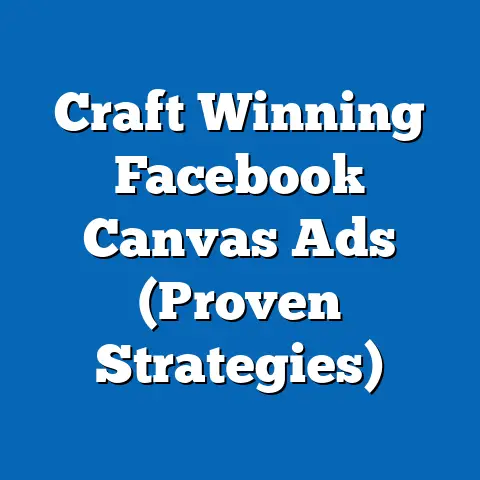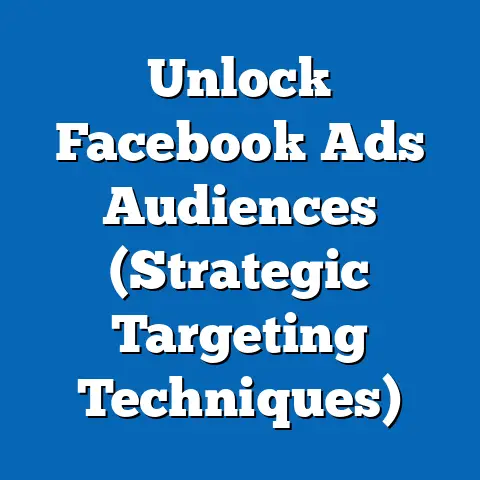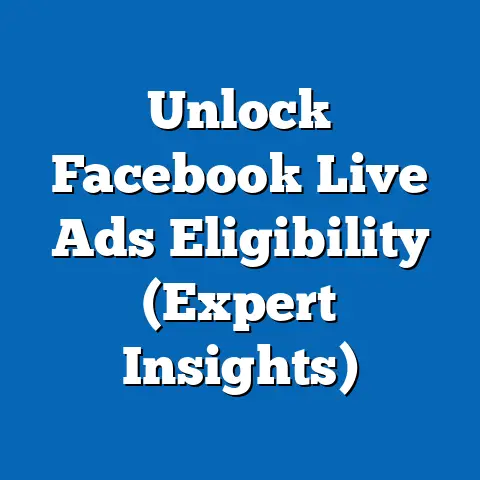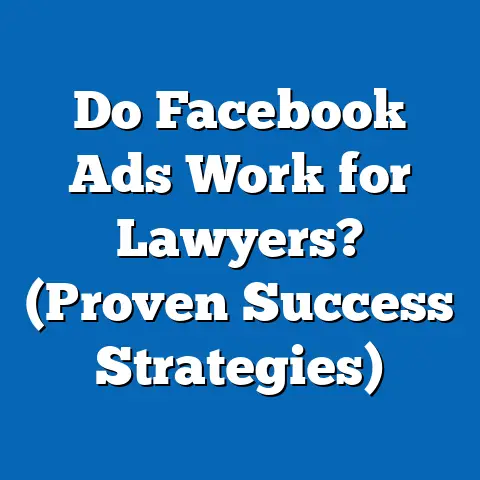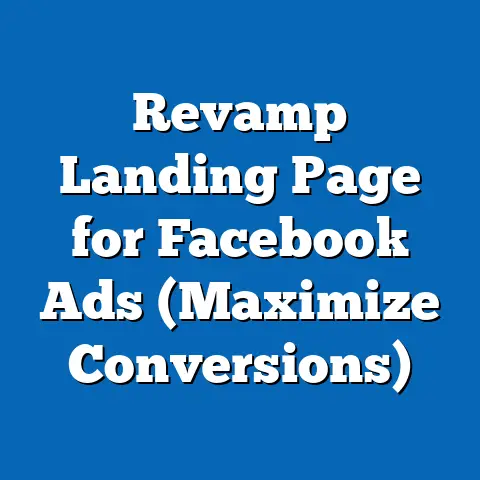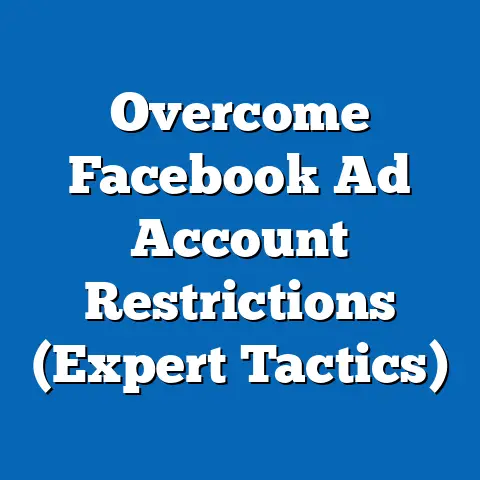Boost Health with Facebook Ads (Proven Strategies)
I remember when I first started consulting with small businesses, I met so many passionate entrepreneurs like Sarah. They had incredible products or services, a genuine desire to help people, but struggled to cut through the noise online. One particular health and wellness business, “Vitality Wellness,” really sticks with me. Sarah, the founder, was deeply committed to organic supplements and holistic health coaching. She started Vitality Wellness out of her passion for healthy living and helping others achieve their wellness goals. She poured her heart and soul into creating high-quality products and developing personalized coaching programs.
But Sarah faced a common challenge: reaching her target audience effectively. Word-of-mouth was slow, and traditional marketing felt outdated and ineffective. Despite having a fantastic product and a compelling mission, Sarah struggled to drive traffic to her website, generate leads, and ultimately boost sales and customer engagement. This is where I knew Facebook Ads could be a game-changer.
Understanding the Power of Facebook Ads in the Health Industry
Facebook’s advertising platform is a powerhouse for businesses in the health and wellness niche. Why? Because it offers an unparalleled combination of reach, targeting capabilities, and affordability.
Think about it: Facebook has billions of active users globally. In fact, as of early 2024, Facebook boasts nearly 3 billion monthly active users. That’s a massive pool of potential customers just waiting to discover your products or services.
But it’s not just about the sheer numbers. What makes Facebook Ads truly powerful is its ability to target specific demographics, interests, and behaviors. You can pinpoint your ideal customers based on age, gender, location, income, education, and a whole host of other factors.
For example, if Sarah from Vitality Wellness wanted to reach fitness enthusiasts in her local area, she could target users who have liked pages related to gyms, yoga studios, or healthy eating. She could also target users who have expressed interest in specific health topics, like weight loss, nutrition, or holistic medicine.
According to recent statistics, health-related businesses that utilize Facebook Ads effectively see an average conversion rate of around 3-5%. This means that for every 100 visitors who click on your ad, 3-5 will make a purchase or take another desired action, such as signing up for a free consultation or downloading a lead magnet.
Moreover, engagement metrics like click-through rates (CTR) and cost per click (CPC) tend to be favorable in the health and wellness niche. This is because people are actively seeking information and solutions related to their health and well-being, making them more receptive to relevant ads.
Another crucial concept to understand is the marketing funnel. This represents the journey a customer takes from initial awareness of your brand to becoming a loyal advocate. Facebook Ads can play a role in every stage of this funnel:
- Awareness: Use broad targeting and engaging content to introduce your brand to a wider audience.
- Consideration: Target users who have shown interest in your brand or related topics with more specific ads that highlight the benefits of your products or services.
- Conversion: Retarget users who have visited your website or engaged with your content with ads that encourage them to make a purchase or take another desired action.
By strategically leveraging Facebook Ads throughout the marketing funnel, you can guide potential customers through each stage of the buying process and ultimately convert them into paying clients.
Key Takeaway: Facebook Ads provide a powerful platform for health businesses to reach a massive audience, target specific demographics, and guide potential customers through the marketing funnel.
Next Step: Start thinking about how Facebook Ads can fit into your overall marketing strategy and how you can use its targeting capabilities to reach your ideal customers.
Defining Your Target Audience for Health Products
One of the biggest mistakes I see businesses make with Facebook Ads is failing to properly define their target audience. It’s tempting to try to reach everyone, but that’s a surefire way to waste your advertising budget. The more specific you can be about who you’re trying to reach, the more effective your ads will be.
Audience segmentation is crucial in health marketing. Not everyone is interested in the same health products or services. Some people are focused on weight loss, others on fitness, and still others on holistic health. You need to identify and target the specific groups of people who are most likely to be interested in what you have to offer.
Here are some common audience personas relevant to health products:
- Fitness Enthusiasts: These individuals are passionate about exercise and maintaining a healthy lifestyle. They’re often interested in supplements that can enhance their performance, aid in recovery, or help them build muscle.
- Individuals Seeking Weight Loss: This group is looking for products or services that can help them lose weight and improve their overall health. They may be interested in diet plans, weight loss supplements, or fitness programs.
- Holistic Health Advocates: These individuals are interested in natural and alternative approaches to health and wellness. They may be interested in organic supplements, herbal remedies, or holistic health coaching.
- Seniors Focused on Healthy Aging: This demographic is concerned with maintaining their health and vitality as they age. They may be interested in supplements that support joint health, cognitive function, or overall well-being.
- Parents Seeking Healthy Options for Their Children: These parents are highly motivated to provide their children with the best possible nutrition and health support. They may be interested in vitamins, organic snacks, or natural remedies for common childhood ailments.
To identify and research your target audience, I recommend using Facebook Insights and Audience Insights tools. These tools provide a wealth of data about the demographics, interests, and behaviors of Facebook users.
Facebook Insights is great for understanding the audience that already interacts with your Facebook page. You can see their age, gender, location, and interests, as well as the types of content they engage with the most.
Audience Insights, on the other hand, allows you to research potential audiences based on a variety of criteria. You can enter in different interests, behaviors, and demographics to see how large the audience is, what other pages they like, and what their purchasing habits are.
For example, if Sarah from Vitality Wellness wanted to target fitness enthusiasts, she could use Audience Insights to see how many people in her local area have liked pages related to gyms, fitness magazines, or athletic apparel brands. She could also see what other interests they have, such as healthy recipes, outdoor activities, or sports teams.
Once you’ve gathered enough data, it’s time to create effective customer personas. A customer persona is a fictional representation of your ideal customer. It should include details about their age, gender, occupation, income, education, interests, goals, and pain points.
Understanding your customer’s pain points is crucial for crafting effective ad copy and targeting. What are their biggest challenges when it comes to their health? What are they struggling with? What are they hoping to achieve?
For example, a customer persona for a weight loss supplement might be a busy working mom who struggles to find time to exercise and eat healthy. Her pain points might include feeling tired and sluggish, being unhappy with her weight, and lacking the energy to keep up with her kids.
By understanding your target audience’s pain points, motivations, and purchasing behaviors, you can create Facebook Ads that resonate with them on a deeper level and ultimately drive more conversions.
Key Takeaway: Defining your target audience is essential for effective Facebook advertising in the health industry. Use Facebook Insights and Audience Insights tools to research your ideal customers and create detailed customer personas.
Next Step: Spend some time researching your target audience and creating customer personas. The more you understand your ideal customers, the more effective your Facebook Ads will be.
Crafting Compelling Ad Copy for Health Products
The ad copy is the heart and soul of your Facebook Ad. It’s what grabs people’s attention, communicates your message, and persuades them to take action. In the health industry, it’s especially important to craft compelling ad copy that resonates with health-conscious consumers.
One of the most important elements of effective ad copy is clarity. You need to be clear about what you’re offering and what the benefits are. Avoid using jargon or technical terms that your target audience may not understand.
For example, instead of saying “Our supplement contains a proprietary blend of adaptogens,” say “Our supplement helps you manage stress and boost your energy levels with natural ingredients.”
Another key element is engagement. You need to grab people’s attention and keep them interested in what you have to say. Use strong headlines that pique their curiosity and draw them in.
Here are some examples of effective ad headlines for health products:
- “Lose Weight Without Dieting or Exercise!” (This headline is attention-grabbing and promises a quick and easy solution.)
- “Boost Your Energy Levels Naturally!” (This headline appeals to people who are looking for a natural way to improve their energy.)
- “Discover the Secret to a Healthier, Happier You!” (This headline is intriguing and promises a transformative experience.)
- “Finally, a Supplement That Actually Works!” (This headline is bold and promises results.)
- “Say Goodbye to Stress and Anxiety!” (This headline targets a specific pain point and offers a solution.)
In the body text of your ad, you should highlight the benefits of your products or services. What problems do they solve? How will they improve your customers’ lives?
For example, if you’re selling a weight loss supplement, you might say “Our supplement helps you burn fat, boost your metabolism, and curb your appetite, so you can lose weight and feel great.”
You should also include a call to action that tells people what you want them to do. Do you want them to visit your website, sign up for a free consultation, or make a purchase? Be clear and specific about what you want them to do.
Here are some examples of effective calls to action for health products:
- “Shop Now!” (This is a straightforward call to action that encourages people to make a purchase.)
- “Learn More!” (This call to action is less direct and encourages people to visit your website to learn more about your products or services.)
- “Sign Up for a Free Consultation!” (This call to action is great for generating leads.)
- “Download Our Free Guide!” (This call to action is a great way to build your email list and provide value to your audience.)
- “Get Started Today!” (This call to action creates a sense of urgency and encourages people to take action immediately.)
One of the most powerful tools you can use in your ad copy is social proof. People are more likely to trust your products or services if they see that other people have had positive experiences with them.
Include testimonials from satisfied customers in your ads. These testimonials should be specific and believable. They should highlight the benefits that customers have experienced from using your products or services.
For example, you might say “I lost 20 pounds in just 8 weeks using this supplement! I feel more energetic and confident than ever before.” – Jane Doe
You can also use reviews and ratings to build trust and credibility. If you have positive reviews on your website or on third-party review sites, highlight them in your ads.
Remember, in the health industry, trust is paramount. People are entrusting you with their health and well-being. You need to demonstrate that you’re a trustworthy and credible source of information and products.
Key Takeaway: Crafting compelling ad copy is essential for attracting attention, communicating your message, and persuading people to take action. Use clear, engaging language, highlight the benefits of your products or services, and include social proof to build trust and credibility.
Next Step: Review your existing ad copy and make sure it’s clear, engaging, and persuasive. Incorporate testimonials and social proof to build trust and credibility.
Designing Eye-Catching Visuals for Facebook Ads
In the fast-paced world of social media, visuals are king. They’re the first thing people see when they scroll through their Facebook feed, and they’re what ultimately determine whether or not someone stops to pay attention to your ad.
The role of visuals in Facebook Ads is to capture attention, communicate your message, and create an emotional connection with your audience. They should be eye-catching, relevant, and high-quality.
When selecting images and videos for your health and wellness ads, it’s important to align them with your brand and your target audience. What kind of images and videos will resonate with your ideal customers?
Here are some best practices for selecting visuals for Facebook Ads in the health industry:
- Use high-quality images and videos: Avoid using blurry or pixelated images. Your visuals should be clear, sharp, and visually appealing.
- Choose images and videos that are relevant to your products or services: Your visuals should accurately represent what you’re selling.
- Use images and videos that evoke emotion: Your visuals should create an emotional connection with your audience. They should make them feel happy, healthy, and inspired.
- Showcase real people: People are more likely to trust ads that feature real people rather than stock photos. Use images and videos of your customers or employees to build trust and credibility.
- Maintain brand consistency: Your visuals should be consistent with your brand’s colors, fonts, and overall aesthetic.
One of the most effective types of visuals you can use in your health and wellness ads is before-and-after images. These images can be incredibly powerful for showcasing the results that your products or services can deliver.
For example, if you’re selling a weight loss supplement, you could use before-and-after photos of customers who have lost weight using your product. If you’re selling a skincare product, you could use before-and-after photos of customers who have seen improvements in their skin.
Infographics are another great way to communicate complex information in a visually appealing way. You can use infographics to share health tips, explain the benefits of your products, or present data in an easy-to-understand format.
Video testimonials are also incredibly effective for building trust and credibility. Hearing real people talk about their positive experiences with your products or services can be much more persuasive than reading written testimonials.
When creating visuals for your Facebook Ads, it’s important to adhere to Facebook’s advertising guidelines. Facebook has strict rules about what you can and can’t include in your ads, especially when it comes to health-related topics.
For example, you can’t make false or misleading claims about your products or services. You can’t use images or videos that are sexually suggestive or that promote violence. And you can’t target people based on their health conditions or medical history.
Make sure you familiarize yourself with Facebook’s advertising guidelines before you start creating your ads. Violating these guidelines can result in your ads being disapproved or your account being suspended.
Key Takeaway: Eye-catching visuals are essential for capturing attention and communicating your message effectively. Use high-quality images and videos that are relevant to your products or services and that evoke emotion. Maintain brand consistency and adhere to Facebook’s advertising guidelines.
Next Step: Review your existing visuals and make sure they’re high-quality, relevant, and engaging. Consider using before-and-after images, infographics, and video testimonials to enhance your ad effectiveness.
Implementing Proven Facebook Ad Strategies for Health Businesses
Now that you understand the basics of Facebook Ads, it’s time to dive into some proven strategies that can help you achieve success in the health industry.
One of the most important strategies is A/B testing. This involves creating multiple versions of your ads and testing them against each other to see which one performs best.
You can A/B test different ad formats (carousel ads, video ads, slideshow ads), different headlines, different body text, different images, and different calls to action.
For example, you could create two versions of your ad with different headlines. One headline might say “Lose Weight Without Dieting or Exercise!” and the other might say “Boost Your Energy Levels Naturally!” Run both ads simultaneously and see which one gets more clicks and conversions.
Another effective strategy is retargeting. This involves targeting people who have already visited your website or engaged with your content. These people are more likely to be interested in your products or services than people who have never heard of you before.
You can retarget website visitors by installing the Facebook Pixel on your website. This pixel tracks the actions that people take on your website, such as visiting specific pages, adding items to their cart, or making a purchase.
You can then create custom audiences based on these actions and target them with ads that are relevant to their interests.
For example, if someone visited your website and looked at a specific weight loss supplement, you could retarget them with an ad that promotes that supplement and offers a discount.
Another powerful strategy is utilizing Lookalike Audiences. This involves creating audiences that are similar to your existing customers. Facebook uses its data to identify people who share similar demographics, interests, and behaviors with your current customers.
This is a great way to expand your reach and find new customers who are likely to be interested in your products or services.
You can create Lookalike Audiences based on your customer list, your website visitors, or your Facebook page fans.
Finally, consider running seasonal campaigns tied to health trends. For example, you could run a campaign promoting fitness products in January to capitalize on New Year’s resolutions. Or you could run a campaign promoting allergy relief products in the spring.
By aligning your ads with seasonal trends, you can increase their relevance and effectiveness.
I’ve seen these strategies work time and time again for health businesses of all sizes. Let me share a quick example. I worked with a local yoga studio that was struggling to attract new students. We implemented a retargeting campaign that targeted people who had visited their website but hadn’t signed up for a class. We also created a Lookalike Audience based on their existing students. Within a few weeks, they saw a significant increase in new student sign-ups.
Key Takeaway: Implementing proven Facebook Ad strategies such as A/B testing, retargeting, Lookalike Audiences, and seasonal campaigns can significantly improve your results in the health industry.
Next Step: Start implementing these strategies in your own Facebook Ad campaigns. A/B test different ad formats and copy, set up retargeting for your website visitors, and create Lookalike Audiences based on your existing customers.
Maximizing Engagement through Facebook Ad Features
Facebook Ads offer a wide range of features that can help you maximize engagement and connect with your audience on a deeper level.
One of the most effective features is Facebook Live. This allows you to broadcast live video to your audience. You can use Facebook Live to host Q&A sessions, conduct product demonstrations, or share health tips.
Facebook Live is a great way to build relationships with your audience and create a sense of community. It also allows you to interact with your audience in real-time and answer their questions.
Another powerful feature is Stories Ads. These are short, vertical videos that appear in the Stories section of Facebook. Stories Ads are a great way to capture attention and engage with your audience in a visually appealing way.
You can use Stories Ads to promote your products or services, share behind-the-scenes content, or run contests and giveaways.
Messenger Ads are another effective way to connect with your audience. These ads appear in the Messenger app and allow you to have one-on-one conversations with potential customers.
You can use Messenger Ads to answer questions, provide customer support, or offer personalized recommendations.
Interactive content like polls and quizzes is also a great way to engage users and collect valuable leads. You can use polls to ask your audience about their health habits or preferences. You can use quizzes to test their knowledge about health topics and provide them with personalized recommendations.
For example, a Vitality Wellness could run a quiz titled “What’s Your Healthiest Self?” and then offer personalized supplement recommendations based on their results.
Facebook Groups can also be a complementary strategy to enhance community building around health topics. You can create a Facebook Group for your customers or for people who are interested in your products or services.
In your Facebook Group, you can share health tips, answer questions, and create a sense of community. This is a great way to build loyalty and turn your customers into advocates for your brand.
I’ve seen firsthand how powerful these features can be. One of my clients, a local nutritionist, started using Facebook Live to host weekly Q&A sessions about healthy eating. She quickly built a loyal following and saw a significant increase in new client inquiries.
Key Takeaway: Facebook Ads offer a wide range of features that can help you maximize engagement and connect with your audience on a deeper level. Utilize Facebook Live, Stories Ads, Messenger Ads, interactive content, and Facebook Groups to build relationships and create a sense of community.
Next Step: Start experimenting with these features in your own Facebook Ad campaigns. Host a Facebook Live session, create a Stories Ad, or start a Facebook Group for your customers.
Measuring Success and Optimizing Ad Campaigns
Measuring the success of your Facebook Ad campaigns is crucial for understanding what’s working and what’s not. Without data, you’re just guessing.
There are several key performance indicators (KPIs) that health businesses should track to measure the success of their Facebook Ads:
- Click-Through Rate (CTR): This is the percentage of people who see your ad and click on it. A high CTR indicates that your ad is relevant and engaging.
- Conversion Rate: This is the percentage of people who click on your ad and take a desired action, such as making a purchase or signing up for a free consultation. A high conversion rate indicates that your ad is effective at driving results.
- Cost Per Click (CPC): This is the amount you pay each time someone clicks on your ad. A low CPC indicates that your ad is efficient at driving traffic.
- Cost Per Conversion (CPC): This is the amount you pay each time someone takes a desired action, such as making a purchase or signing up for a free consultation. A low CPC indicates that your ad is efficient at driving results.
- Return on Ad Spend (ROAS): This is the amount of revenue you generate for every dollar you spend on advertising. A high ROAS indicates that your ad is profitable.
To analyze your ad performance, you’ll need to use Facebook Ads Manager. This is the tool that Facebook provides for creating and managing your ad campaigns.
In Ads Manager, you can see detailed data about your ad performance, including impressions, clicks, conversions, and cost. You can also segment your data by demographics, interests, and behaviors to see which audiences are performing best.
The key to successful Facebook advertising is ongoing optimization. You should be constantly monitoring your ad performance and making adjustments to improve your results.
Here are some things you can do to optimize your ad campaigns:
- Adjust your targeting: If you’re not reaching the right people, your ads won’t be effective. Experiment with different targeting options to see what works best.
- Reallocate your budget: If some of your ads are performing better than others, reallocate your budget to focus on the top performers.
- Refresh your creative: Over time, your ads can become stale and less effective. Refresh your creative with new images, videos, and ad copy to keep things fresh.
- Test different ad formats: Experiment with different ad formats to see which ones resonate best with your audience.
I always tell my clients that Facebook advertising is not a “set it and forget it” activity. It requires constant monitoring, analysis, and optimization.
Key Takeaway: Measuring the success of your Facebook Ad campaigns is crucial for understanding what’s working and what’s not. Track key performance indicators (KPIs), analyze your ad performance using Facebook Ads Manager, and make ongoing adjustments to optimize your results.
Next Step: Start tracking your ad performance and making adjustments to improve your results. Pay attention to your CTR, conversion rate, CPC, and ROAS. Experiment with different targeting options, budget allocations, creative refreshes, and ad formats.
Conclusion
Facebook Ads have the power to transform health businesses like “Vitality Wellness.” By implementing these proven strategies, you can increase your visibility, engage with your target audience, and ultimately drive more sales.
I’ve seen firsthand how Facebook Ads can help health businesses achieve their goals. It’s not always easy, but with the right strategies and a commitment to ongoing optimization, you can achieve significant results.
I encourage you to take action and explore the possibilities of Facebook Ads to boost your health-focused ventures. Start by defining your target audience, crafting compelling ad copy, and designing eye-catching visuals. Then, implement proven strategies like A/B testing, retargeting, and Lookalike Audiences. Finally, measure your results and optimize your campaigns on an ongoing basis.
The world of Facebook advertising is constantly evolving, but the fundamental principles remain the same. By focusing on providing value to your audience, building trust and credibility, and continuously improving your campaigns, you can achieve lasting success.

